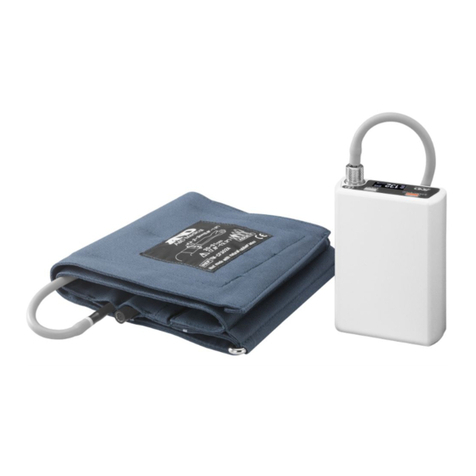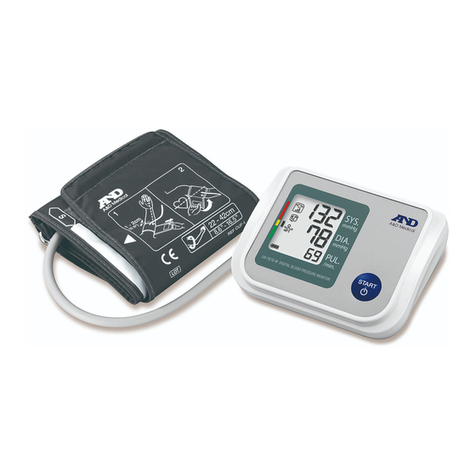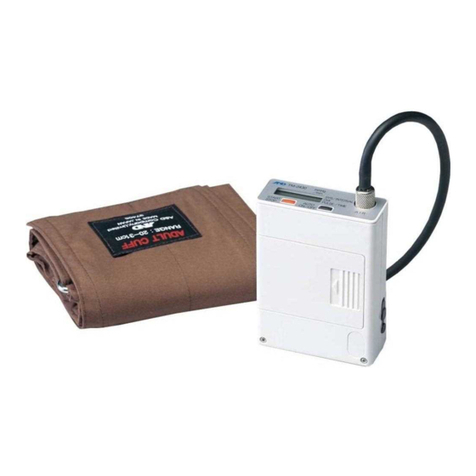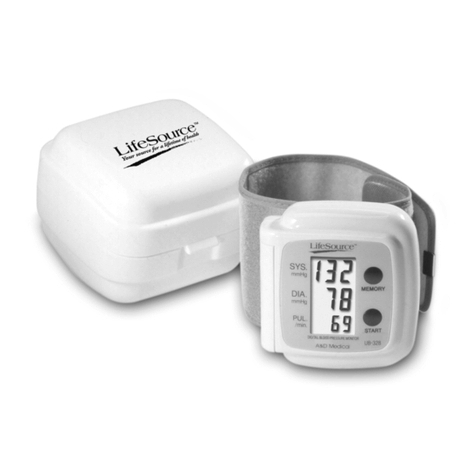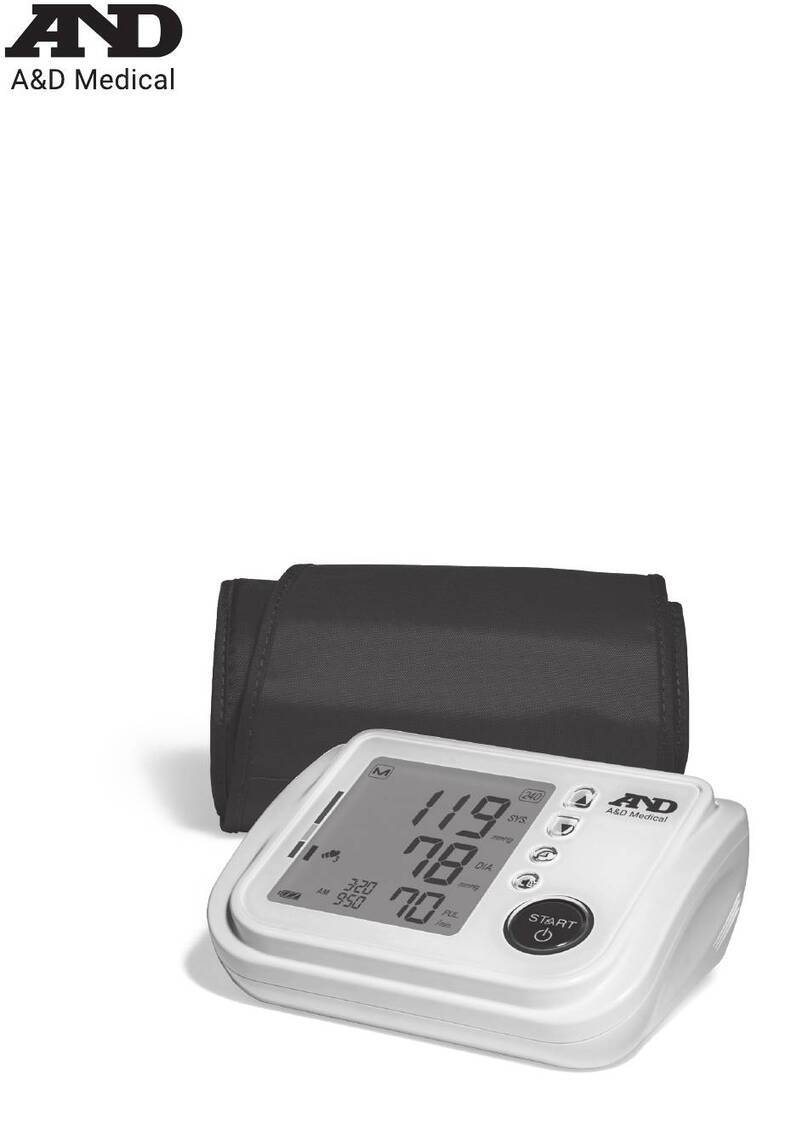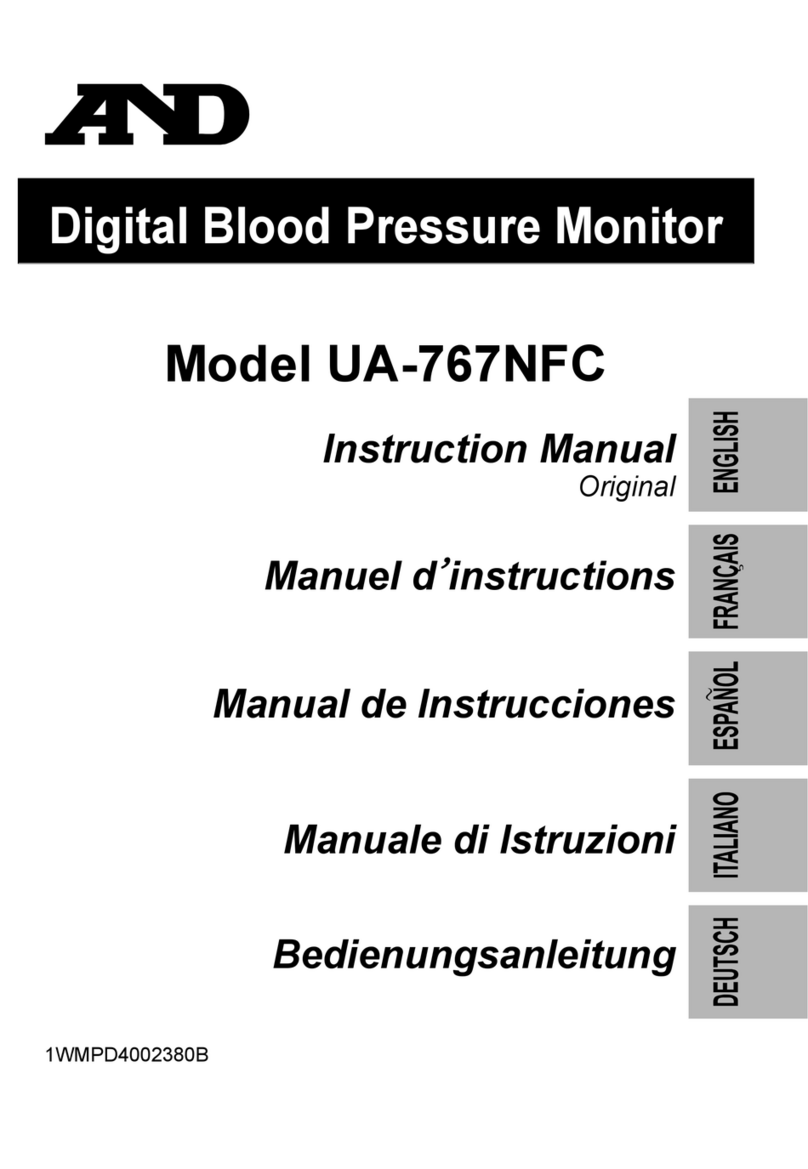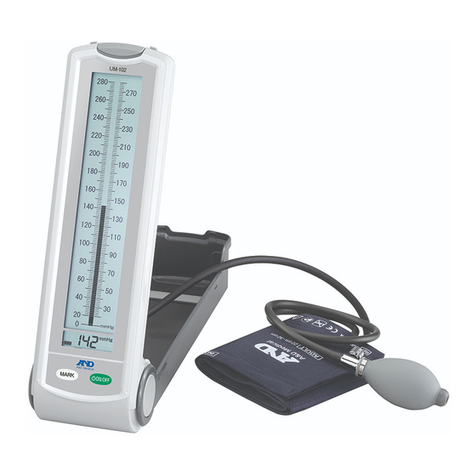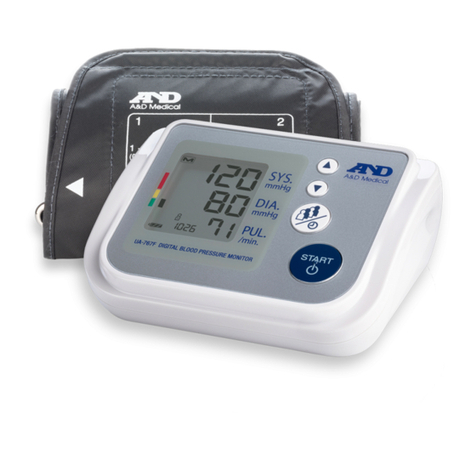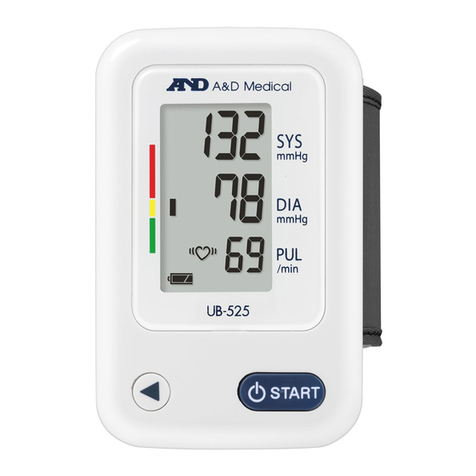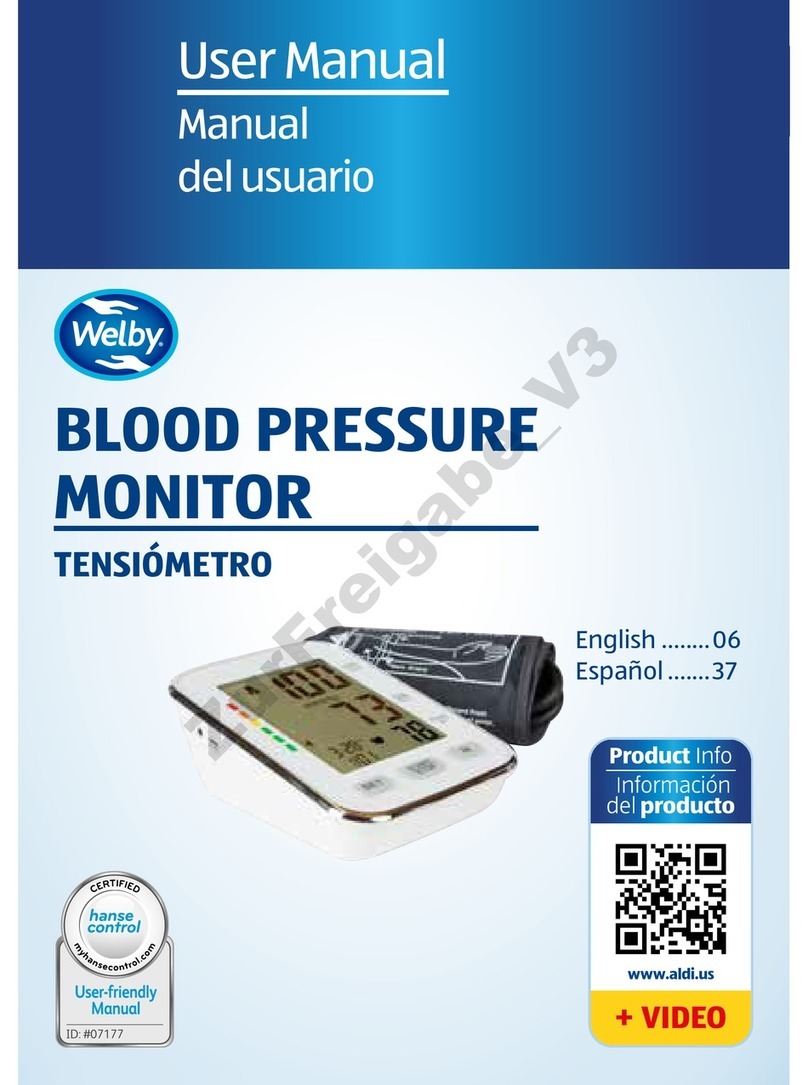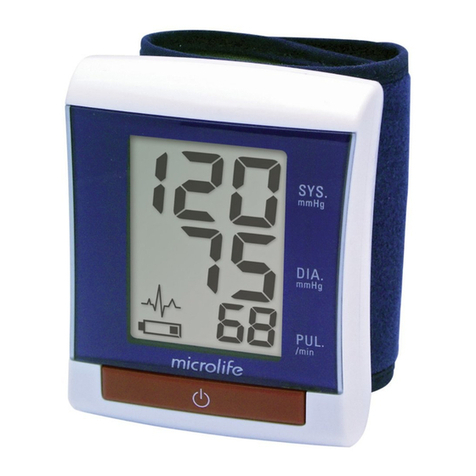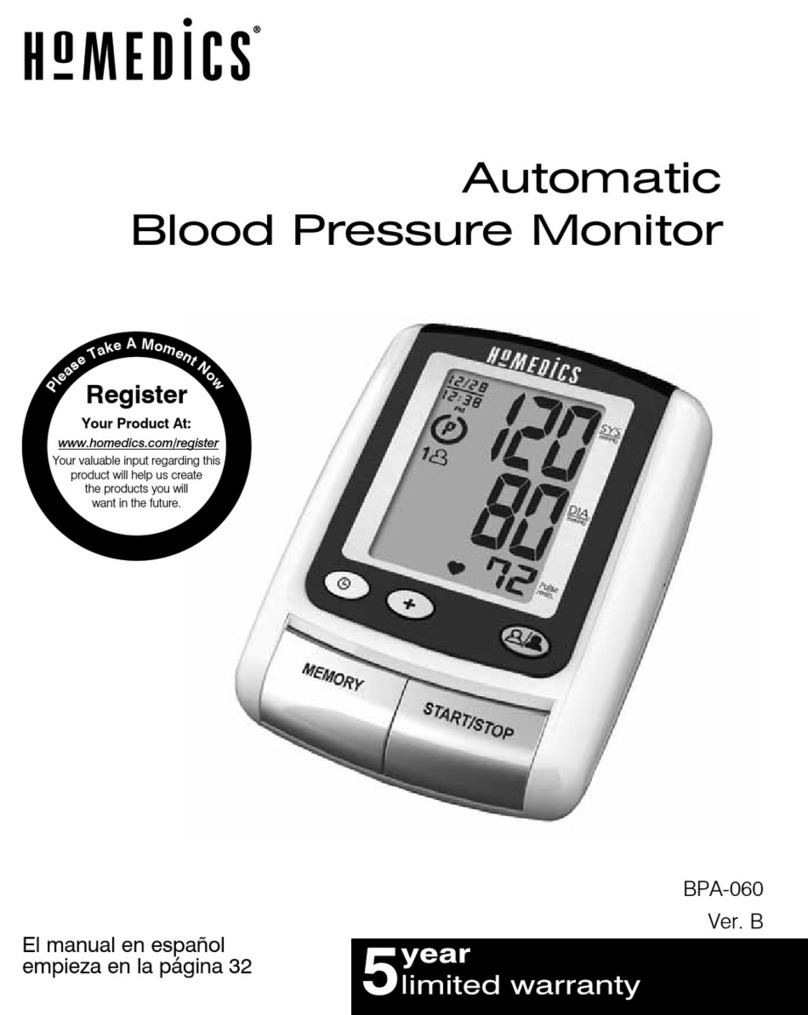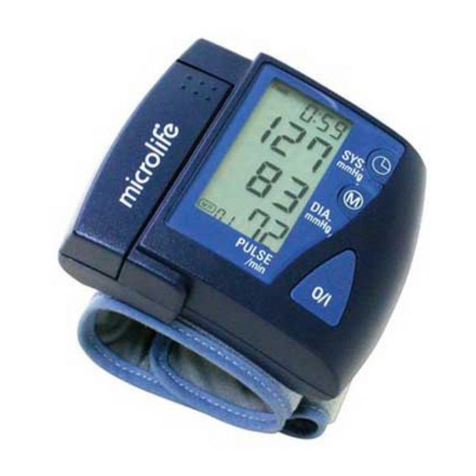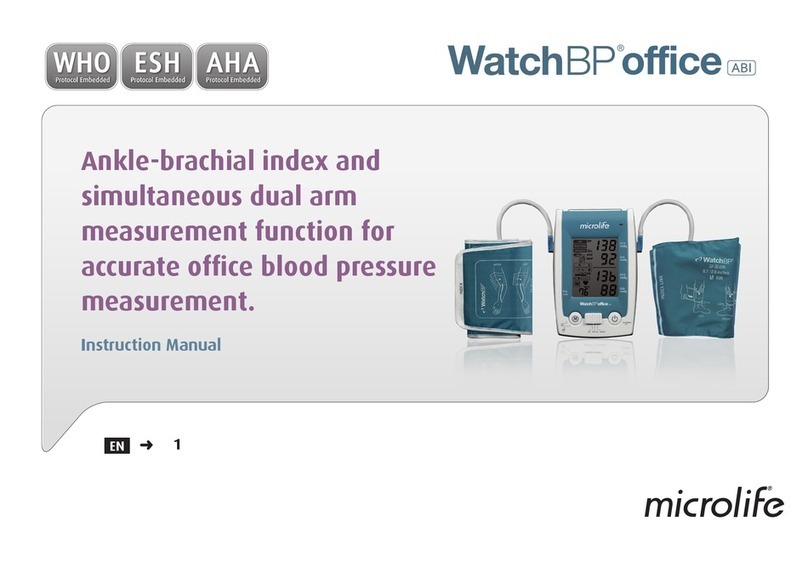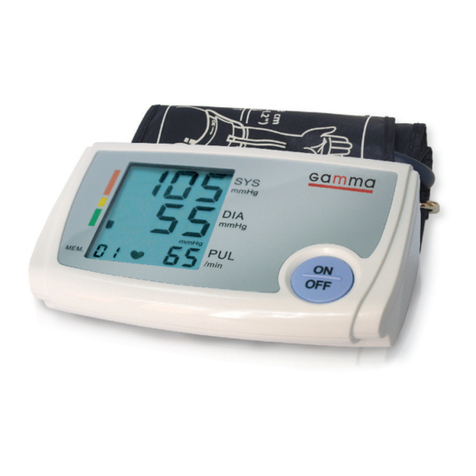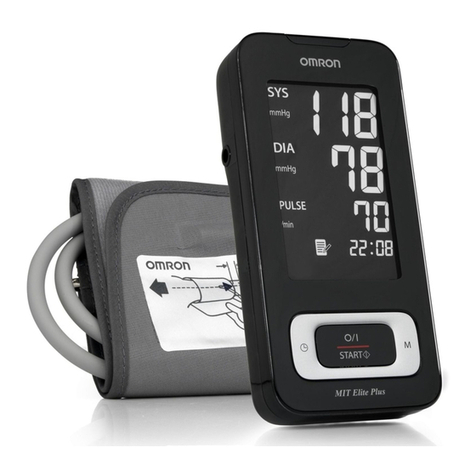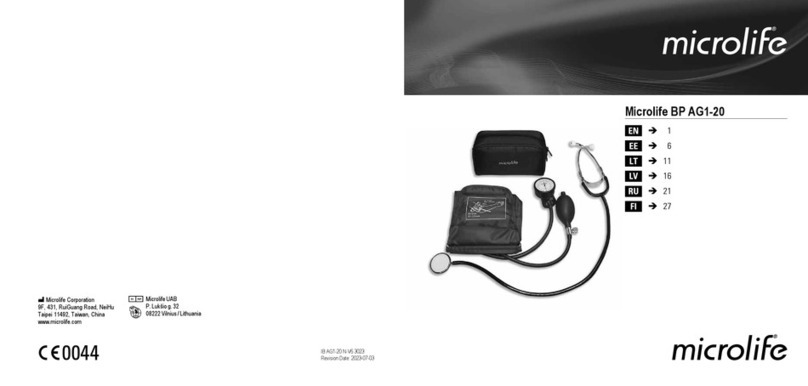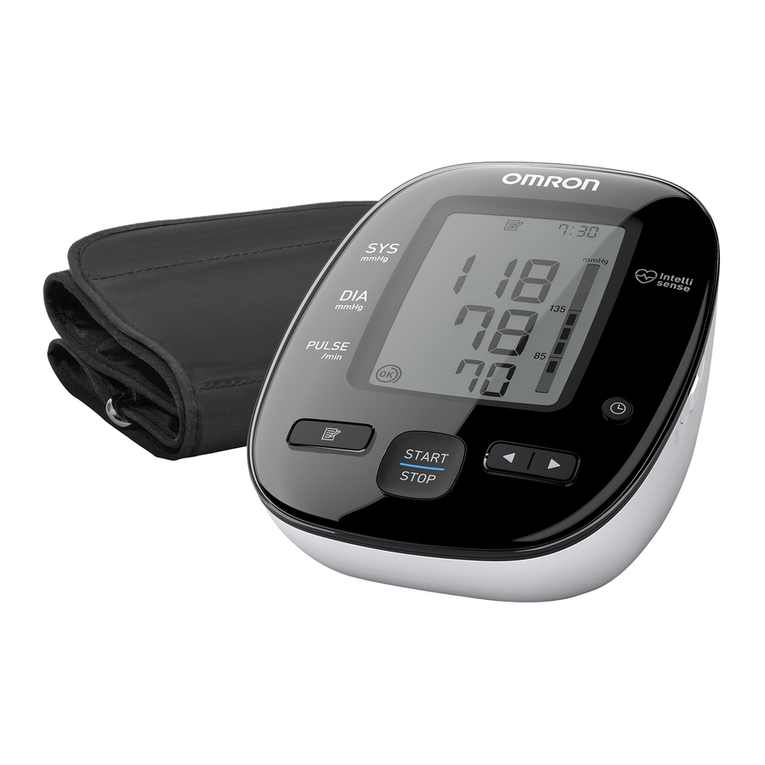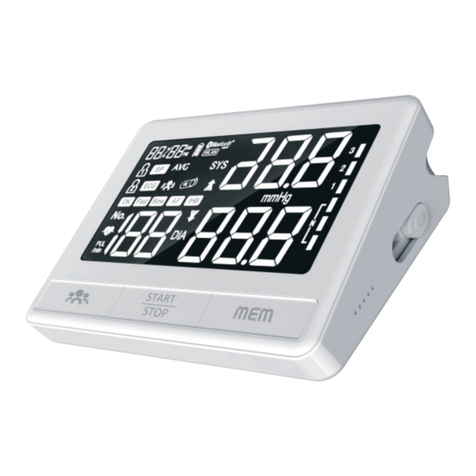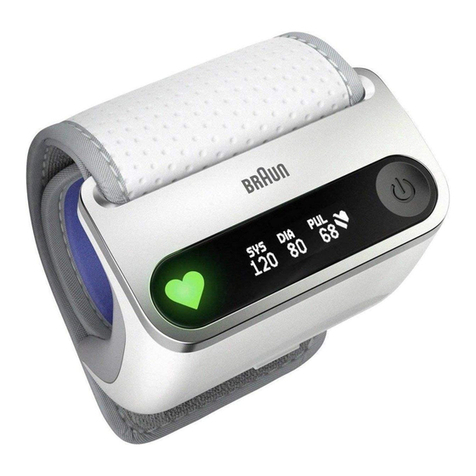AND UA-767S-W User manual

Digital Blood Pressure Monitor
Model UA-767S-W
1WMPD4004363A
사
용
설명
서
번
역
េស
វ
េ
ែ
ណ
ចប់បកែប
C
ẩ
m nang hư
ớ
ng d
ẫ
n
Bản dịch
คู่มือการใช้งา
น
แปล
Instruksi Manual
Ter
j
emahan
使
用
手冊
翻譯
Instruction Manua
l
Original ENGLISH
中文
한국어
Bahasa Indonesia
Malay
ภาษาไทย
Tiếng Việt
ែខរ
T
aga
l
og
Manwal ng Tagubilin
Pagsasalin
Manual Arahan
Ter
j
emahan


English 1
Contents
Dear Customers...................................................................... 2
Preliminary Remarks............................................................... 2
Precautions............................................................................. 2
Parts Identification ................................................................. 5
Symbols.................................................................................. 6
Operation Mode...................................................................... 8
Using the Monitor................................................................... 9
Installing / Changing the Batteries .................................... 9
Connecting the Air Hose.................................................. 10
Connecting the AC Adapter ............................................. 10
Selecting the Correct Cuff Size ........................................ 11
Applying the Arm Cuff..................................................... 11
How to Take Accurate Measurements.............................. 13
Measurement................................................................... 13
After Measurement.......................................................... 13
Measurements ...................................................................... 14
Normal Measurement ...................................................... 14
Measurement with the Desired Systolic Pressure............. 15
Notes for Accurate Measurement .................................... 15
Recalling the Memory Data................................................... 16
What Is The IHB/AFib Indicator? ........................................... 17
What Is The AFib? ................................................................. 17
%IHB/AFib............................................................................ 17
Pressure Bar Indicator........................................................... 18
WHO Classification Indicator ................................................ 18
About Blood Pressure ........................................................... 18
What is Blood Pressure? ................................................... 18
What is Hypertension and How is it Controlled? .............. 19
Why Measure Blood Pressure at Home? ........................... 19
WHO Blood Pressure Classification .................................. 19
Blood Pressure Variations................................................ 19
Troubleshooting................................................................... 20
Maintenance ......................................................................... 20
Technical Data...................................................................... 21

English 2
Dear Customers
Congratulations on purchasing a state-of-the-art A&D blood pressure
monitor. Designed for ease of use and accuracy, this device will facilitate
your daily blood pressure regimen.
We recommend that you read through this manual carefully before
using the device for the first time.
Preliminary Remarks
The device is designed for use on adults, not newborns or infants.
Environment for use. The device is for use to operate by yourself in the
home healthcare environment.
This device is designed to measure blood pressure and pulse rate of
people for diagnosis.
Precautions
Precision components are used in the construction of this device. Extremes
in temperature, humidity, direct sunlight, shock or dust should be avoided.
Clean the device and cuff with a dry, soft cloth or a cloth dampened with
water and a neutral detergent. Never use alcohol, benzene, thinner or
other harsh chemicals to clean the device or cuff.
Avoid tightly folding the cuff or storing the hose tightly twisted for long
periods, as such treatment may shorten the life of the components.
Take care to avoid accidental strangulation of babies or infants with the hose
and cable.
Do not twist the air hose during measurement. This may cause injury due
to continuous cuff pressure.
The device and cuff are not water resistant. Prevent rain, sweat and water
from soiling the device and cuff.
Measurements may be distorted if the device is used close to televisions,
microwave ovens, cellular telephones, X-ray or other devices with strong
electrical fields.
Wireless communication devices, such as home networking devices, mobile
phones, cordless phones and their base stations, walkie-talkies can affect
this blood pressure monitor.
Therefore, a minimum distance of 30 cm should be kept from such devices.
When reusing the device, confirm that the device is clean.
Used equipment, parts and batteries are not treated as ordinary household
waste, and must be disposed of according to the applicable local
regulations.

English 3
When the AC adapter is used, make sure that the AC adapter can be
readily removed from the electrical outlet when necessary.
Do not modify the device. It may cause accidents or damage to the device.
To measure blood pressure, the arm must be squeezed by the cuff hard
enough to temporarily stop blood flow through the artery. This may cause
pain, numbness or a temporary red mark to the arm. This condition will
appear especially when measurement is repeated successively. Any pain,
numbness, or red marks will disappear with time.
Measuring blood pressure too frequently may cause harm due to blood flow
interference. Check that the operation of the device does not result in
prolongedimpairment ofbloodcirculation, when using the device repeatedly.
If you have had a mastectomy, please consult a doctor before using the device.
Do not let children use the device by themselves and do not use the device
in a place within the reach of infants. It may cause accidents or damage.
There are small parts that may cause a choking hazard if swallowed by
mistake by infants.
Unplug the AC adapter when not in use during the measurement.
Use of accessories not detailed in this manual may compromise safety.
Should the battery short-circuit, it may become hot and potentially cause
burns.
Allow the device to adapt to the surrounding environment before use (about
one hour).
Clinical testing has not been conducted on newborn infants and pregnant
woman. Do not use on newborn infants or pregnant woman.
Do not touch the batteries, the DC jack, and the patient at the same time.
That may result in electrical shock.
Do not inflate without wrapping the cuff around the upper arm.
Contraindications
The following are precautions for proper use of the device.
Do not apply the cuff on an arm with another medical electrical equipment
attached. The equipment may not function properly.
People who have a severe circulatory deficit in the arm must consult a
doctor before using the device, to avoid medical problems.
Do not self-diagnose the measurement results and start treatment by
yourself. Always consult your doctor for evaluation of the results and
treatment.
Do not apply the cuff on an arm with an unhealed wound.
Do not apply the cuff on an arm receiving an intravenous drip or blood
transfusion. It may cause injury or accidents.
Do not use the device where flammable gases such as anesthetic gases
are present. It may cause an explosion.

English 4
Do not use the device in highly concentrated oxygen environments, such
as a high-pressure oxygen chamber or an oxygen tent. It may cause a fire
or explosion.

English 5
Air Connector Plug
Air Socket
Proper Fit Range
Index Mark
Battery Compartment
Display
Battery Cover
Arm Cuff
AC adapter Plug
DC Jack
START Button
Air Hose
Artery Position Mark
1.5V Batteries
(R6P, LR6 or AA)
Parts Identification
WHO Classification Indicator
and Pressure Bar Indicator
MEMORY
Systolic
Pressure
Diastolic
Pressure
Pulse Rate
Battery Indicator
Heart Mark
IHB/AFib symbol
Movement Error Symbol
Cuff Fit Error Symbol
Average
Display
%IHB/AFib

English 6
Symbols
Symbols that are printed on the device case
Symbols
Function / Meaning
Standby and Turn the device on.
SYS
Systolic blood pressure in mmHg
DIA
Diastolic blood pressure in mmHg
PUL
Pulse per minute
Battery installation guide
Direct current
Type BF: Cuff is designed to provide special protection against
electrical shocks.
Manufacturer
Date of manufacture
IP
International protection symbol
Used equipment, parts and batteries are not treated as ordinary
household waste, and must be disposed of according to the
applicable local regulations.
SN
Serial number
Refer to instruction manual/booklet
Polarity of DC jack
Keep dry
Symbols that appear on the display
Symbols
Function / Meaning
Recommended Action
Appears while measurement is in
progress. It blinks when the pulse is
detected.
Measurement is in
progress. Remain as
still as possible.
IHB/AFib symbol
Appears when an irregular heartbeat
is detected.
It may light when a very slight
vibration like shivering or shaking is
detected.
Appears when a body or arm movement
is detected.
The reading may yield
an incorrect value. Try
the measurement again.
Remain still during
measurement.

English 7
Symbols
Symbols
Function / Meaning
Recommended Action
Appears during measurement
when the cuff is attached loosely
The reading may yield an
incorrect value. Apply the
cuff correctly, and try the
measurement again.
Detected rate of IHB/AFib in memory
Previous measurements stored in
MEMORY.
Average data
FULL BATTERY
The battery power indicator during
measurement.
LOW BATTERY
The battery is low when it blinks.
Replace all batteries with new
ones when the mark blinks.
Unstable blood pressure due to
movement during measurement.
Try the measurement again.
Remain verystill during
measurement.
The systolic and diastolic values
are within 10 mmHg of each other.
Apply the cuff correctly,
and try the measurement
again.
The pressure value did not
increase during the inflation.
The cuff is not applied correctly.
PUL DISPLAY ERROR
The pulse is not detected correctly.
Blood pressure monitor internal
error
Remove the batteries and
press the START button,
and then install the batteries
again. If the error still
appears, contact the dealer.
%IHB/AFib =
x100 [%]
Number of detected
IHB/AFibs in memory
Total number

English 8
Operation Mode
1. Normal Measurement
Press the START button. Blood pressure is measured and the data is stored
in memory. This device can store the last 60 measurements in memory.
2. Recalling the Data
When nothing is displayed, press and hold
the START button.
Release the button when displaying the
average data.
The data number and stored data are
automatically displayed in order from the
last measurement.
For details on recalling the data, Refer to
“Recalling the Memory Data”.
3. Deleting all Data Stored in Memory
When turning off the device, press and hold the
START button until the " " is displayed.
Select " " to clear data.
Data is cleared when the mark blinks.
The device turns off automatically.
4. Measurement with the Desired Systolic Pressure
Refer to page 15 for measurement with the desired systolic pressure.
START
START

English 9
Using the Monitor
Installing / Changing the Batteries
1. Remove the battery cover.
2. Remove the used batteries and
insert new batteries into the battery
compartment as shown, taking care
that the polarities (+ and -) are
correct.
Use only R6P, LR6 or AA batteries.
3. Attach the battery cover.
CAUTION
Insert the batteries as shown in the battery compartment. If installed
incorrectly, the device will not work.
When
(
LOW BATTERY mark
)
blinks on the display, replace all batteries
with new ones. Do not mix old and new batteries. It may shorten the battery
life, or cause the device to malfunction.
Replace the batteries two seconds or more after the device turns off.
If
(
LOW BATTERY mark
)
appears even after the batteries are replaced,
make a blood pressure measurement. The device may then recognize the
new batteries.
(
LOW BATTERY mark
)
does not appear when the batteries are drained.
The battery life varies with the ambient temperature and may be shorter at
low temperatures. Generally, four new LR6 batteries will last approximately
for one year when used twice for measurement each day.
Use the specified batteries only. The batteries provided with the device are
for testing monitor performance and may have a limited life.
Remove the batteries if the device is not to be used for a long time.
The batteries may leak and cause a malfunction.
Step 3
Step 2
Step 1
Step 1

English 10
Using the Monitor
Connecting the Air Hose
Insert the air connector plug into
the air socket firmly.
Connecting the AC Adapter
Insert the AC adapter plug into the
DC jack.
Next, connect the AC adapter to
an electrical outlet.
Use the specified AC adapter.
(Refer to page 21.)
When disconnecting the AC adapter from the electrical outlet, grasp and
pull the AC adapter body out of the outlet.
When disconnecting the AC adapter plug from the blood pressure
monitor, grasp and pull the AC adapter plug out of the monitor.
Air socket
r socket
Air connector plug
AC adapter plug
DC jack

English 11
Using the Monitor
Selecting the Correct Cuff Size
Using the correct cuff size is important for an accurate reading. If the cuff is
not the proper size, the reading may yield an incorrect blood pressure value.
The arm size is printed on each cuff.
The index and proper fit range, on the cuff, tell you if you are applying the
correct cuff. (Refer to"Symbols that are printed on the cuff" on the next page)
If the index points outside of the range, contact your local dealer to
purchase a replacement cuff.
The arm cuff is a consumable. If it becomes worn, purchase a new one.
Arm Size
Recommended Cuff Size
Catalog Number
31 cm to 45 cm
Large Adult Cuff
CUF-D-LA-ISO
22 cm to 42 cm
Wide Range Cuff
CUF-I-ISO
23 cm to 37 cm
Semi Large Cuff
CUF-D-MA-ISO
22 cm to 32 cm
Adult Cuff
CUF-F-A-ISO
Arm size: The circumference at the biceps.
Note: The UA-767S-W is not designed for using a small cuff.
Applying the Arm Cuff
1. Wrap the cuff around the upper
arm, about 1 - 2 cm above the
inside of the elbow, as shown.
Place the cuff directly against the
skin, as clothing may cause a faint
pulse, and result in a measurement
error.
2. Constriction of the upper arm,
caused by tightly rolling up a
shirtsleeve, may prevent accurate
readings.
3. Confirm that the index points
within the proper fit range.
Donotrollupshirtsleevetightly.
1-2 cm
Air Hose
Cuff
Arteryposition mark
Index and proper fit range
Secure the fabric
fastener firmly.

English 12
Using the Monitor
Symbols that are printed on the cuff
Symbols
Function / Meaning
Recommended Action
Artery Position Mark
Set the mark on the
artery of the upper arm or
in line with the ring finger
on the inside of the arm.
▲
Index
Catalog number
Proper fit range for the large adult cuff.
It's printed on the large adult cuff.
Proper fit range for the wide range cuff.
It's printed on the wide range cuff.
Proper fit range for the semi large
cuff. It's printed on the semi large
cuff.
Proper fit range for the adult cuff.
It's printed on the adult cuff.
Under range printed on the large
adult cuff.
Use the semi large cuff
instead of the large adult
cuff.
Under range printed on the adult
cuff/semi large cuff/wide range cuff.
Over range printed on the adult
cuff/semi large cuff/wide range cuff.
Use the large adult cuff
instead of the adult cuff
/semi large cuff /wide
range cuff.
Lot number
Manufacture
Medical Device
Large Adult cuff
Wide range cuff
Adult cuff
Proper fit range
WS
ALS
L
AL
M

English 13
Semi Large cuff
Using the Monitor
How to Take Accurate Measurements
For the most accurate blood pressure measurement:
Sit comfortably on a chair. Rest your arm on the table. Do not cross your
legs. Keep your feet flat on the floor and straighten your back.
Relax for about five to ten minutes before measurement.
Place the center of the cuff at the same level as your heart.
Remain still and keep quiet during measurement.
Do not measure right after physical exercise or a bath. Rest for twenty or
thirty minutes before taking the measurement.
Try to measure your blood pressure at the same time every day.
Measurement
During measurement, it is normal for the cuff to feel very tight. (Do not be
alarmed).
After Measurement
After measurement, press the START button to turn the device off.
Remove the cuff and record your data.
Note: Thedevicehas anautomaticpowershut-off function,whichturnsthedevice
off approximately one minute after measurement.
Allow at least three minutes between measurements on the same person.
M
L
S

English 14
Measurements
Before measurement, refer to “Notes for Accurate Measurement”on the
next page.
Normal Measurement
1. Place the cuff on the arm (preferably the left arm).
Sit quietly during measurement.
2. Press the START button.
All of the display segments are displayed.
Zero (0) is displayed blinking briefly.
The display changes, as indicated in the
figure at the right, as the measurement
begins. The cuff starts to inflate. It is
normal for the cuff to feel very tight. A
pressure bar indicator is displayed, on the
left edge of the display, during the
inflation.
Note: If you wish to stop inflation at any time,
press the START button again.
3. When inflation is complete, deflation
starts automatically and (heart mark)
blinks, indicating that the measurement is
in progress. Once the pulse is detected,
the mark blinks with each pulse beat.
Note: If an appropriate pressure is not obtained,
the device starts to inflate again
automatically.
To avoid re-inflation, refer to “Measurement
with the Desired Systolic Pressure”on the
next page.
4. When the measurement is complete, the
systolic and diastolic pressure readings
and pulse rate are displayed.
The cuff exhausts the remaining air and
deflates completely.
5. Pressthe START buttontoturnthedeviceoff.
After one minute of non-operation, the
device will turn off automatically.
Note: Allow at least three minutes between
measurements on the same person.
START
At heart level
Measurement
in progress
Systolic pressure
Diastolic pressure
WHO classification
Pulse rate
Exhausts remaining
air automatically
Press
Pressurizing
Zero display
Starts inflation
All of the display
segmentsdisplayed

English 15
Measurements
Measurement with the Desired Systolic Pressure
The UA-767S-W is designed to detect the pulse and to inflate the cuff to a
systolic pressure level automatically.
Use this method when re-inflation occurs repeatedly or when the results
are not displayed even if the pressure decreases to 20 mmHg or less.
1. Place the cuff on the arm at heart level
(preferably the left arm).
2. Press the START button.
3. When the zero blinks, press and hold
the START button until a number
about 30 to 40 mmHg higher than
your expected systolic pressure
appears.
4. When the desired number is reached,
release the START button to start
measurement. Continue to measure
your blood pressure as described on
the previous page.
Notes for Accurate Measurement
Sit down in a comfortable position. Place your arm on a table with your
palm facing upward and the cuff at the same level as your heart.
Relax for about five to ten minutes before taking a measurement. If you
are excited or depressed by emotional stress, the measurement will reflect
this stress as a higher (or lower) than normal blood pressure reading and
the pulse reading will usually be faster than normal.
An individual's blood pressure varies constantly, depending on what you
are doing and what you have eaten.What you drink can have a very strong
and rapid effect on your blood pressure.
This device bases its measurements on the heartbeat. If you have a very
weak or irregular heartbeat, the device may have difficulty determining
your blood pressure.
Shouldthedevicedetectaconditionthatis abnormal,it willstopthemeasurement
anddisplayanerrorsymbol.Refertopage7forthedescriptionofsymbols.
Refer to the previous page
for measurement
Press the
button
At heart level
Release the button
at the desired
systolic pressure
Press and hold
the button
START
START

English 16
This device is intended for use by adults. Consult with your physician
before using this device on a child. A child should not use this device
unattended.
The automatic blood pressure monitor’s performance may be affected by
excessive temperature or humidity, or altitude.
Recalling the Memory Data
Note: This device stores the last 60 measurements in memory.
1. When nothing is displayed, press
and hold the _START_ button to
recall the stored data.
2. Release the button when displaying
the average data.
3. The data number and stored data
are automatically displayed in order
from the last measurement.
4. The display will turn off
automatically after all data is
displayed.
Note: If you press the _START_ button
while recalling data, the device
turns off.
Average of
all the data
Average systolic
Average diastolic
Average pulse
Press and
hold
Most recent data
Last data (Oldest)
Systolic
Diastolic
Pulse
button
Systolic
Diastolic
Pulse
START

English 17
What Is The IHB/AFib Indicator?
When the monitor detects an irregular rhythm during the measurements,
the IHB/AFib indicator will appear on the display with the measurement
values.
Note: We recommend contacting your physician if you see this
IHB/AFib indicator frequently.
What Is The AFib?
The heart contracts due to electrical signals occurring in heart and sends
blood through the body. Atrial fibrillation (AFib) occurs when the electrical
signal intheatriumbecomes confusedand leadstodisturbancesinthepulse
interval. AFib can cause blood to stagnate in the heart, which can easily
create clots of blood, a cause of stroke and heart attack.
%IHB/AFib
%IHB/AFib is displayed as frequency of IHB/AFib detected.
IHB/AFib can detect not only noises such as physical movement but also
an irregular heartbeat. Therefore, we recommend contacting your
physician if %IHB/AFib level is high.
Display of %IHB/AFib:%IHB/AFib is displayed when displaying average values.
(Refer to “2. Recalling the Data”in “Operation Mode”)
%IHB/AFibisnotdisplayedwhenthememorynumberis sixorless.
Average value display
Level 0
%IHB/AFib=0
Level 1
%IHB/AFib=1 - 9
Level 2
%IHB/AFib=10- 24
Level 3
%IHB/AFib=25- 100
Not displayed
%IHB
/AFib
=
x 100 [%]
Number of detected
IHB/
AFib
s in memory
Total number

English 18
Pressure Bar Indicator
The indicator monitors the progress of pressure during measurement.
WHO Classification Indicator
Each segment of the bar indicator
corresponds to the WHO blood pressure
classification described on the next page.
About Blood Pressure
What is Blood Pressure?
Blood pressure is the force exerted by blood against the walls of the arteries.
Systolic pressure occurs when the heart contracts. Diastolic pressure occurs
when the heart expands. Blood pressure is measured in millimeters of
mercury (mmHg). One's natural blood pressure is represented by the
fundamentalpressure, whichis measuredfirst thinginthe morning whileone
is still at rest and before eating.
WHO Classification Indicator
Severe hypertension
Moderate hypertension
Mild hypertension
High normal
Normal
Optimal
The indicator displays a segment, based
on the current data, corresponding to the
WHO classification.
:
Inflation complete
Pressurizing
Inflation in progress Measurement in progress
Releasing air
Example:
Moderate hypertension
Mild hypertension
High normal
Other manuals for UA-767S-W
2
This manual suits for next models
1
Table of contents
Languages:
Other AND Blood Pressure Monitor manuals


